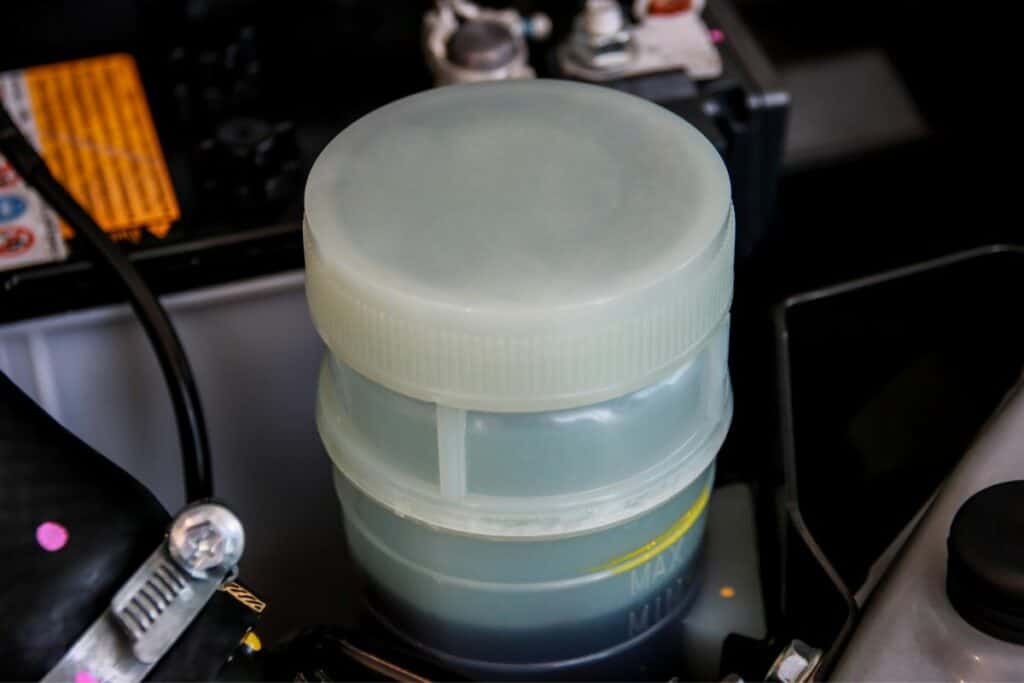As the miles go by, the power steering fluid in your vehicle loses its properties, and its color changes. It may be subject to leakage or external contamination, which is why it’s so important to change the fluid before that happens.
A high-performance power steering fluid provides better vehicle control, reduces the effort required to operate the steering wheel, and helps the driver adjust the steering so the vehicle’s trajectory doesn’t change.

You might wonder what color power steering fluid is, and I’m here to tell you. I’ve worked in automotive industry for several years, and will share my knowledge with you.
Table of Contents
What Color is Power Steering Fluid?
The composition of hydraulic fluids varies, but so does their color. It’s extremely important to note that the color can vary depending on the steering fluid manufacturer and vehicle make, but you can’t rely on the color to choose the one that fits your power steering system. The most common power steering fluid colors are green, red, and clear.
Let’s take a closer look:
1. Green
Pentosin, a German company, manufactures green power steering fluid. It is mainly used in Ford, BMW, Volkswagen, Audi, Bentley, Volvo, and Daimler AG vehicles. You can also find green steering fluid in the aftermarket, depending on the brand you choose.
2. Red
Red is the most common color on the market so that people can easily recognize the origin of a leak. Most fluids that your vehicle needs have specific colors to recognize them, too. Red power steering fluid is called Dexron, and it is made to meet the standards set by General Motors. These fluids are also produced under license and are used in vehicles made by Nissan, Toyota, Mazda, Hyundai, and Kia.
3. Clear
It’s important to remember that the color doesn’t show what the fluid is made of. For example, Dexron oils are all the same color (red) but can be mineral or synthetic. On the packaging, it says what standards the steering fluid meets and what kinds of vehicles it can be used in. Most commonly, clear power steering fluid can be found in Mercedes-Benz vehicles. It is developed by the Daimler Group but is also manufactured by other companies under license. Sometimes, fluid manufacturers choose not to add dye to the fluid because adding dye could cause a reaction that would change how well the fluid works.
Power Steering Fluid Types

Power steering fluid is a type of hydraulic fluid that helps a vehicle’s steering. Power steering systems use a pump to pressurize the fluid, which is then used to push against pistons in the steering mechanism to help turn the wheels. The type of fluid used in the steering system can significantly affect how well it works and how long it lasts.
There are four different kinds of power steering fluid: mineral, semi-synthetic, synthetic, and universal. Each has its own unique properties and characteristics, and it’s important to use the correct type of fluid for your vehicle to ensure proper operation and avoid damage to the power steering system.
1. Mineral power steering fluid
This is the most basic and traditional type of power steering fluid. It’s derived from petroleum and is relatively inexpensive. However, it can be less effective at high temperatures and may not provide as much protection for the power steering system as the other types of fluid.
2. Semi-synthetic power steering fluid
Semi-synthetic steering fluid is a blend of mineral fluid and synthetic fluid. It’s made to offer some of the same benefits as synthetic steering fluid but at a lower price. It may be a good option for those who want to upgrade from mineral steering fluid but don’t want to pay the higher price of synthetic fluid.
3. Synthetic power steering fluid
Synthetic steering fluid is made from artificially created lubricants that are designed to provide better performance and protection than mineral or semi-synthetic steering fluid. It’s usually more expensive, but it can protect the power steering system better and work well in hot weather.
4. Universal power steering fluid
Universal power steering fluid is designed to be compatible with a wide range of power steering systems and can be used in place of other types of fluid. But it might not work as well or protect as well as a type of fluid that is made for a specific power steering system. It’s important to check the manufacturer’s recommendations and make sure that universal fluid is suitable for your vehicle before using it.
Please note that it’s mandatory to use the correct type of steering fluid for your vehicle and not only rely on the color of the steering fluid. If you use the wrong type of fluid, the power steering system could be damaged and the manufacturer’s warranty could be voided. Check your owner’s manual or talk to a mechanic to find out what kind of fluid your vehicle needs.
What Color is Power Steering Fluid when it’s Leaked?
If you notice a leak of steering fluid under your vehicle, you can use the fluid’s color to help pinpoint where the problem is coming from. If your transmission fluid leak color is different than originally, you may have an issue. Knowing what causes the different colors will assist you in quickly identifying the potential cause of the issue and the best course of action for fixing it before it gets worse.
Let’s take a closer look at the different colors you might be seeing:
1. Red, green, or clear Power Steering Fluid
If you find a red, green, or clear fluid under your car, you probably have a recent leak. Since these are the original colors of the steering fluid, you have the chance to notice it in time and take immediate action. This can be due to a leaking seal or a badly connected hose.
2. Milky or Foamy Power Steering Fluid
Your steering fluid may appear milky or foamy for several reasons:
- It may have been contaminated with water.
- Seals that are worn could allow air to enter the steering system, which would cause the fluid to foam.
- When the steering system gets too hot, the fluid can boil and create foam.
The reason why the steering fluid is foamy or milky needs to be found because it could be a sign of a more serious problem with the steering system. It’s best to have a mechanic figure out what’s wrong and take the necessary actions to avoid major issues.
3. Yellow Steering Fluid
There is only one potential cause of yellow steering fluid: if it gets contaminated with coolant over time, its color will change to yellow. This is rare, but if it happens, a leaky seal may be to blame for this. If you notice that your steering fluid is yellow, you should have a mechanic look at it.
4. Brown and Black Steering Fluid
There could be several reasons why you have brown and black steering fluid:
- It’s normal for the fluid to become slightly brown or black as it ages, but if it’s significantly darker than when it was new, it could be a sign of a problem.
- If your steering system has been damaged by corrosion, the fluid may look brown or black.
- If the steering system has not been properly maintained or has experienced a lot of wear and tear, it may cause the fluid to appear brown or black.
It’s important to find out what’s causing the brown or black steering fluid as soon as possible and fix it since it can cause problems with the steering system and lead to bigger problems.
How To Replace Steering Fluid?

Changing the steering fluid is a fairly easy job that can be done with just a few tools. Here is a general outline of the steps you can follow to replace the steering fluid in your vehicle:
- Before you begin, gather all of the tools you will need. This may include a wrench or socket set, a container to catch the old fluid, new steering fluid, and a funnel.
- Locate the power steering pump and reservoir. This is typically near the front of the engine. The reservoir is the container that holds the steering fluid. It’s usually made of plastic and has a transparent section so you can see the level of the fluid.
- Identify the hose or line leading from the pump to the reservoir. This is the component that will need to be loosened to allow the old fluid to drain out. Use the wrench or socket to loosen the bolt or clamp that secures the hose or line in place.
- Once the hose or line is loose, allow the old fluid to drain out into the container you have placed underneath it. This may take a few minutes.
- Once the fluid has stopped draining, tighten the hose or line back into place using the wrench or socket.
- Remove the cap from the reservoir and pour in the new steering fluid. You may need to use a funnel to prevent spilling. Make sure to check the owner’s manual for the correct type and amount of steering fluid to use.
- Check the fluid level in the reservoir and add more fluid as needed until It’s at the proper level. The level should be between the “minimum” and “maximum” marks on the side of the reservoir.
- Start the engine and turn the steering wheel from lock to lock a few times to circulate the new fluid. This will help to ensure that the new fluid is distributed throughout the steering system.
- Check the fluid level again and top off as needed. Make sure the level stays between the “minimum” and “maximum” marks on the side of the reservoir.
That’s it! Your steering fluid has now been replaced. It’s a good idea to consult your vehicle’s owner’s manual for specific instructions, as the process can vary slightly from one make and model to another. It’s also a good idea to consult a mechanic if you aren’t certain you’ve done a good job.
What Could Happen If You Drive With Discolored Power Steering Fluid?
If you drive with discolored power steering fluid, it could potentially cause problems with your vehicle’s power steering system. The power steering system is responsible for helping you turn the steering wheel more easily, and it relies on fluid to help transmit power and keep the system functioning properly.
Driving with discolored power steering fluid could lead to several problems, including:
1. Decreased power steering performance:
Discolored steering fluid may not be able to transmit power as effectively, which can make it more difficult to turn the steering wheel.
2. Increased wear and tear on the system:
Discolored steering fluid can cause increased wear and tear on the power steering pump and other components, potentially leading to premature failure.
3. Power steering failure:
When the fluid becomes discolored, it could cause the power steering system to fail, making it difficult or impossible to steer the vehicle.
4. Noise:
If the fluid is discolored, it could cause the steering pump to make noise, such as squealing.
5. Vibrations:
If the fluid is discolored, its level is low, or the steering pump is failing, it could cause the steering wheel to vibrate or shake.
6. Loss of control:
In the worst cases, driving with discolored steering fluid could cause the power steering system to fail, causing a loss of control and a possible safety hazard.
7. Leaks:
Discolored power steering fluid could cause seals and gaskets in the power steering system to fail, leading to leaks.
Any problems with the power steering system should be fixed as soon as possible because they could lead to bigger issues if they are not fixed. If you are experiencing any of these problems or if you notice that your power steering fluid is discolored, it’s recommended that you have the system checked by a mechanic as soon as possible.
In the meantime, try to avoid making sharp turns or driving at high speeds, as these activities can put additional strain on the power steering system. When the power steering fails, it can also compromise your ability to steer the vehicle safely.
Check our article on Steering Wheel Lock Up While Driving
FAQ
Here below you find the most frequently asked questions about power steering fluids.
Is Power Steering or Transmission Fluid Red?
Power steering fluid can be red, but some manufacturers make green or clear steering fluid. It’s important to use the correct type of fluid for your vehicle, as using the wrong type of fluid can damage your vehicle.
Can You Use Transmission Fluid on Power Steering?
If you need fluid for your steering system, it’s important to use the type of fluid that the vehicle manufacturer specifies. In some cases, it’s possible to use transmission fluid as a temporary replacement if power steering fluid is not available.
How Much Does Power Steering Fluid Cost?
The cost of steering fluid can vary depending on the brand and type you choose. In general, you can expect to pay $7 to $30 for a bottle of power steering fluid.
What Color is Dirty Power Steering Fluid?
Power steering fluid can become used, dirty, or contaminated over time as it circulates through the system. When this happens, the fluid can take on a variety of colors, including milky white, foamy, yellow, brown, or black.
Does Power Steering Fluid Color Matter?
Power steering fluid can become used, dirty, or contaminated over time as it circulates through the system. When this happens, the fluid can take on a variety of colors, including milky white, foamy, yellow, brown, or black.
Conclusion
To make sure your vehicle’s power steering system works well, you should check and change your power steering fluid regularly. Neglecting to change the fluid can lead to issues such as steering problems, leakage, and failure of the power steering pump. Don’t forget that your power steering system is expensive and that it is made up of several components that can deteriorate quickly, as the steering is used continuously while driving. Not to mention the time and money spent on labor if the system is difficult to reach.
By using high-quality power steering fluid, you can help your power steering system last longer and make your vehicle run better overall. I recommend that you read your owner’s manual or talk to a mechanic to find out what kind of power steering fluid is right for your make and model of car and how often you should change it.
